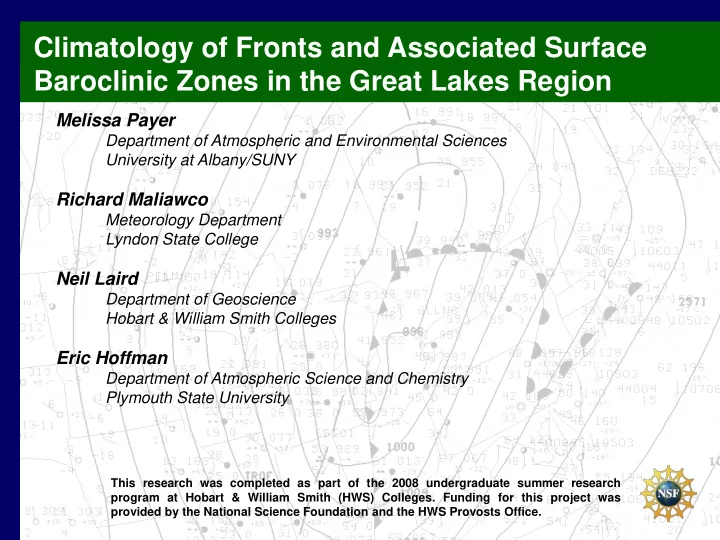

Climatology of Fronts and Associated Surface Baroclinic Zones in the Great Lakes Region Melissa Payer Department of Atmospheric and Environmental Sciences University at Albany/SUNY Richard Maliawco Meteorology Department Lyndon State College Neil Laird Department of Geoscience Hobart & William Smith Colleges Eric Hoffman Department of Atmospheric Science and Chemistry Plymouth State University This research was completed as part of the 2008 undergraduate summer research program at Hobart & William Smith (HWS) Colleges. Funding for this project was provided by the National Science Foundation and the HWS Provosts Office.
Introduction Motivation Frontal passages are a critical factor in influencing weather in the region: - lake effect snow - air mass distribution - severe thunderstorms - pollution transport Objectives Determine the spatial and temporal frequency of fronts and troughs across the Great Lakes region and examine their association with surface baroclinic zones. Previous Studies • Created frequency maps for fronts over North America Morgan et al. (1975) • Wintertime (Nov-Mar) climatology of frontal passages in Great Lakes region Cousins (2006) • Found cold fronts were most common, followed by warm, occluded and stationary • Investigated the degree of correspondence between baroclinic Sanders and Hoffman zones and operational frontal analyses (2002), Hoffman (2008) • Concluded many fronts are not associated baroclinic zones
Frontal Frequency: Data and Methodology Analysis Time Period Jan 2000 – Dec 2005 0000, 0600, 1200, 1800 UTC NCEP Surface Analysis 8,663 examined 1.2% missing Identified 2,173 Fronts & 1,075 Troughs Type First/Last Appearance Date and Time Lakes and States/Provinces Crossed Analyst name Methods Accepted NCEP analysis as is Front must cross over at least one lake Identified each frontal segment – along each boundary there can be multiple frontal classifications (e.g., cold stationary)
Composite of Surface Analyses (Uccellini et al. 1992)
Analyst Consistency with Frontal Analyses n=33 Small interquartile ranges suggest some consistency across analysts in analyzing fronts. Larger variability across analysts in analyzing troughs Distribution of the number of Distribution of the percentage of analyses for each analyses each analyst completed analyst where front or trough was indicated
Frequency of Fronts & Troughs: 2000-2005 Represents the number of fronts and troughs followed for their entire evolution within Great Lakes region
Frequency of Front & Trough Passages: 2000-2005 Observed Represents the number of fronts and troughs which passed over each individual Great Lake. As an example, a single cold front would be counted for Lakes Superior and Michigan if it had passed over both during its evolution. Represents the frequency of fronts and troughs (per km 2 ) Normalized which passed over each individual Great Lake Lake Surface Area (km 2 ) Lake Superior: 82,100 Lake Huron: 59,600 Lake Michigan: 57,800 Lake Erie: 25,700 Lake Ontario: 18,960
SLP Composites for Fronts that Crossed all Five Lakes n=208 n=24 Warm Fronts Cold Fronts n=10 n=16 Occluded Fronts Stationary Fronts
Baroclinic Zones: Data & Methodology Analysis Time Period Baroclinic Zone Strength * 2-m potential temperature Jan 2000 – Dec 2001 Strong > 7 ° C (100 km) -1 North American Regional Moderate > 3.5 ° C (100 km) -1 Reanalysis (NARR) 0000, 0600, 1200, 1800 UTC 19 May 2001 0000 UTC * Sanders and Hoffman (2002)
Baroclinic Zones: Data & Methodology (continued) Baroclinic zone must be: along 50% of the front’s within 45° of the front’s within 200 km of the front length orientation 1 Jan 2000 1800 UTC
Fronts & Troughs related to Baroclinic Zones: 2000-2001 100 75 70 63 Percent 51 46 50 45 none 44 weak/none 41 37 moderate moderate 28 strong strong 25 25 17 15 14 12 5 2 0 trough cold warm stationary occluded Represents the percentage of analyses with fronts that were associated with a baroclinic zone Note: NCEP uses 1.2 ° C(100 km) -1 as the minimum requirement for frontal zone
Idealized Examples of Trough Length Scale Mesoscale Trough Sub-synoptic Trough Synoptic Trough
SLP Composites for Each Trough Length Scale n=750 n=153 Synopic Troughs Sub-synoptic Troughs n=176 MesoscaleTroughs
Trough Length Scale Related to Baroclinic Zones: 2000-2001 75 74 52 50 40 Percent none weak/none 35 36 moderate 32 moderate strong strong 24 25 20 16 6 0 synoptic sub-synoptic mesoscale Represents the percentage of analyses with troughs that were associated with a baroclinic zone
Summary: Front & Trough Frequency • Cold fronts are the most common in the Great Lakes region, followed by stationary, warm, and occluded fronts. • Troughs are more frequent than cold fronts. • The frequency of fronts and troughs decreases from west to east across the lakes. • There is a larger frequency (per km 2 ) of troughs and fronts over Lakes Ontario and Erie.
Summary: Fronts & Troughs with Baroclinic Zones • 51% of all analyzed fronts in the Great Lakes region are associated with baroclinic zones. - Stationary and warm fronts are most often associated with baroclinic zones (~ 60% of the time). - Association is less for cold and occluded fronts (~50% and ~30% of the time, respectively). - Only 8.7% of all fronts are associated with strong baroclinic zones. • Association of baroclinic zones with troughs increases as trough length decreases (from synoptic to mesoscale).
Spare Slides
SLP Composites for Troughs that Crossed all Five Lakes n=15 Troughs
Surface Analysis 01 Jan 2000 18 UTC
Recommend
More recommend